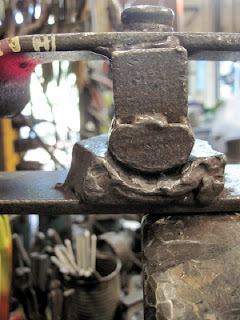This is my “tip of the hat” to some folks who have helped me a lot. Kan Fab is my primary site for obtaining all the materials I need to do my forging operations. I visit their facility several times a week to discuss pattern design, project planning, or to pick up orders. We have collaborated on a couple of projects too.
Early on, I started making decisions about how the number of parts needed determined the cost efficiency of how they were made. If I only needed a few pieces I could cut them out with a torch and clean up the slag and quickly get going. If I needed 20 or 50 or more parts the cleanup time became too expensive. I used some laser cut blanks for a while but the service wasn’t available locally so I had to add in shipping cost. Eventually I switched to water jet cutting which was done by Kan Fab and no shipping costs were incurred. An additional benefit was the convenience of getting easy person to person consultation about designs.
When I first started my relationship with Kan Fab I was getting my steel stock form another source but I soon switched to them because of the convenience and good service. Usually I could drive there and pick what I needed from their “in-house” stock. If the material was a bit odd I learned to place an order a few days in advance of the date I needed it. They get the stock from their supplier and cut the pieces into approximately 10’ lengths so I can transport it I my truck.
I do some work for a chimney sweep and he requests firebacks, smoke guards, fire starters and other hearth related items with custom decorative accents. I don’t have the big shearing and breaking equipment needed to make those things. Kan Fab does all of that and I do whatever additional finish work is needed. It has been interesting to see how the product has been perfected over several years.
Kan Fab is also the source of the punch drops which I use in my tumbler. After a lot of experimenting, I found that mild steel punch drops with a mass somewhere between a pea and a grape are the perfect aggregate for removing fire scale and burrs. I have to take a bucket and a magnet out there and sort out only the mild steel drops of the size I need. It is a bit tediuous but necessicary. So far, they haven’t charged me for them.
I’ve been wanting to make a hydraulic bender for a couple of years. It’s probably the last piece of power equipment I’ll put in the studio. I collected most of the hydraulic parts but never found the time to put everything together so I recently asked them to put it together for me. They have the equipment and skill to do a better job of it. I’m looking forward to seeing how it comes out.
I knew quite a bit about blacksmithing before I started any relationship with engineering/fabricating facilities. As I entered into their realm it was a great educational experience. I got acquainted with ironworkers, presses, breaks, milling machines, metal lathes, massive drill presses, and other industrial machines.
As interesting as it has been seeing how the big boys play, I’ll be content to do my small scale forging work. I have a hard enough time wrapping my mind around my own stuff. I don’t have the space for the really big machines. I don’t have the knowledge to operate or maintain them and I don’t want that overhead expense. However, someone has to do it. In Emporia it is Kan Fab. Good Job!













































